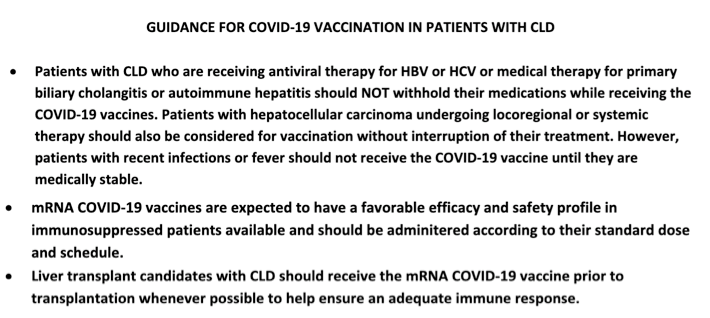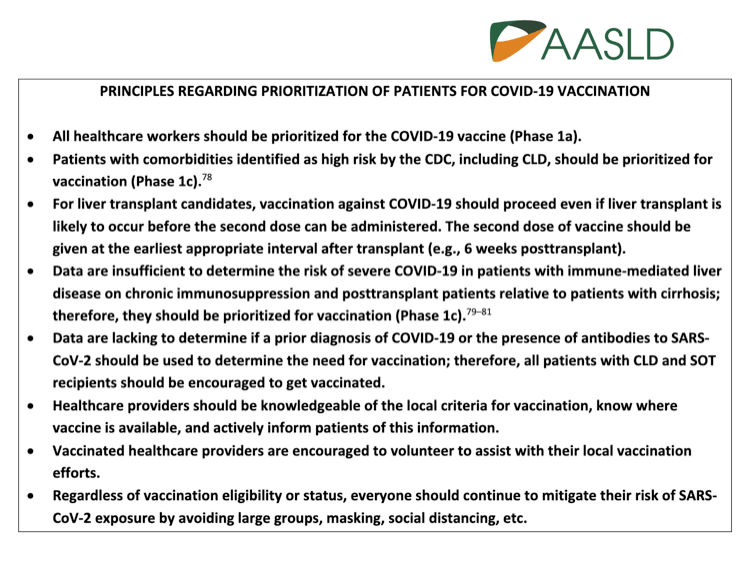| |
AASLD EXPERT PANEL CONSENSUS STATEMENT: VACCINES TO PREVENT COVID-19 INFECTION IN PATIENTS WITH LIVER DISEASE
|
| |
| |
LINK.....
NEW! Download AASLD's Expert Panel Consensus Statement Vaccines to Prevent COVID-19 Infection in Patients with Liver Disease. [Updated: February 2, 2021]
All healthcare workers should be prioritized for the COVID-19 vaccine (Phase 1a). •Patients with comorbidities identified as high risk by the CDC, including CLD, should be prioritized for vaccination (Phase 1c).78
Excerpts
CONCLUSION
Since the identification of the SARS-CoV-2 genome in January 2020, remarkable progress has been made in the development of two highly effective and generally safe mRNA vaccines for COVID-19. The CDC currently recommends that all adults over the age of 18 should receive these 2-dose vaccines according to the manufacturers’ recommendations to prevent future COVID-19. Pre- and post-vaccination serological testing is not recommended due to the absence of studies regarding their impact on outcomes. Due to their mechanism of action, both mRNA COVID-19 vaccines are recommended for all patients with CLD (compensated or decompensated) and immunosuppressed SOT recipients. The AASLD recommends that providers advocate for prioritizing patients with compensated or decompensated cirrhosis or liver cancer, patients receiving immunosuppression such as SOT recipients, and living liver donors for COVID-19 vaccination based upon local health policies, protocols, and vaccine availability. The clinical impact of SARS-CoV-2 viral variants is a rapidly evolving area, and until further studies are available, COVID-19 vaccination should not be withheld or deferred in any patient because of efficacy or safety concerns. All COVID-19 vaccine recipients are recommended to continue social distancing, masking, frequent hand washing, and follow other exposure-mitigating behaviors.
COVID-19 Vaccination in Patients with Chronic Liver Disease
Due to the increased mortality with COVID-19 infection in adult CLD patients and particularly those with cirrhosis, it is recommended that these patients be prioritized for COVID-19 vaccination (Phase 1c). Although safety and efficacy data with the two available mRNA vaccines in CLD patients are limited, adverse events are not anticipated to be more frequent nor is efficacy expected to be lower than the general population; however, additional prospective studies are needed. Although studies of patients with alcohol-associated liver disease suggest they may have worse outcomes with COVID-19,82 it is unknown if vaccination safety or efficacy will differ compared to other CLD patients. If the supply of COVID-19 vaccine is limited, it is reasonable to prioritize patients with higher MELD or CTP scores for vaccination or those who are anticipated to undergo imminent liver transplantation, but all CLD patients should be vaccinated whenever possible.

COVID-19 Vaccination Knowledge Gaps
Patients with advanced CLD and liver transplant recipients have not been included in the mRNA vaccine studies and as such data on effectiveness and safety are lacking in these populations. Post-marketing research is being conducted on antibody response to COVID-19 vaccines in patients with chronic conditions, including cirrhosis and autoimmune diseases. Acute and chronic liver diseases encompass a wide spectrum of etiologies and severity of disease and thus represent a heterogeneous population. Further, there are known racial and ethnic differences in prevalence and incidence of various liver diseases.85,86 Several confounders such as obesity, diabetes mellitus, hypertension, and alcohol use may impact immune regulation, liver disease progression and severity that are relevant in the context of vaccination.86,87 Cirrhosis is inherently a state of qualitative and quantitative immune dysregulation,1 while some patients may be further immunosuppressed with medications such as transplant recipients and those with autoimmune hepatitis. Increasing liver disease severity has been associated with lower non-COVID-19 vaccine responsiveness.88,89 Thus, there are large knowledge gaps in various areas related to liver disease and transplantation that require special attention in further studies. (Table 2)
--------------------
Innate immunity provides the first line of defense through a system of cell surface and intracellular pattern recognition receptors that recognize pathogen- and danger-associated molecular patterns (PAMPs or DAMPs). Adaptive immunity, mediated by B- and T-cells, is required for effective and durable pathogen-specific protective immunity that forms the basis for vaccination. Recent reviews have highlighted the range of immune dysfunction observed in the setting of cirrhosis.7,8 (Supplemental Figure 1) In addition, lack of T-cell help has been associated with nonalcoholic fatty liver disease,9 altered B-cell function has been reported in hepatitis C virus (HCV)-related cirrhosis, and chronic HBV has been associated with global and virus-specific B- and T-cell dysfunction.10–12 Although the degree of immune dysregulation is higher in patients with more severe or decompensated liver disease compared to those with compensated liver disease, this has not been precisely quantified.
The available evidence suggests that, while influenza virus does not directly target the liver, it contributes to collateral liver damage14 and promotes hepatic decompensation.15,16 In several studies, patients with CLD had a significantly increased risk of hospitalization and death related to influenza infection.2,17 T he available evidence suggests that, while influenza vaccine may not protect against all-cause mortality, it triggers an effective antibody response and may reduce the risk of all-cause hospitalization in patients with CLD.2 Therefore, the Centers for Disease Control and Prevention (CDC) and others recommend routine annual vaccination in CLD patients.
COVID-19 VACCINES IN PATIENTS WITH CHRONIC LIVER DISEASE AND IMMUNOSUPPRESSION
Patients with Liver Disease in COVID-19 Vaccine Clinical Trials
Patients with stable chronic medical conditions such as compensated CLD, HIV, HBV, or HCV were eligible to participate in both the Pfizer-BioNTech and Moderna Phase 3 trials. However, those on immunosuppressive therapy were excluded.
In the Pfizer-BioNTech Phase 2/3 trial, 20.5% of study participants had a comorbidity defined by the Charlson Comorbidity Index categories, which include liver disease (8030 with a comorbidity received BNT162b2 and 8029 received placebo). VE was 95.3% in participants with comorbidities and was similar to that seen in patients without comorbidities (94.7%). Among the 214 participants (0.6%) with liver disease, 124 received BNT162b2 and 90 received placebo, but safety and efficacy data in this subgroup have not yet been reported.
In the Moderna Phase 3 trial, at least one high risk condition was present in 22.3% of the participants. Among the 196 (0.6%) participants with liver disease, 100 received mRNA-1273 and 96 received placebo. Since no participants with liver disease developed COVID-19, VE cannot be determined for this subgroup.
Prioritization of the Limited Supply of COVID-19 Vaccines
The COVID-19 vaccines are currently a limited resource that requires rational selection of the highest risk candidates for priority access. Providers must administer COVID-19 vaccines in accordance with prioritization groups determined by appropriate public health authorities.70 The CDC has published a dynamic document that ranks groups at high risk for exposure or poor outcome from COVID-19 (Phases 1a, 1b, 1c, 2).71 Healthcare workers are prioritized by the CDC (Phase 1a) to receive the COVID-19 vaccines because of their high risk of exposure to SARS-CoV-2, the need to protect patients from infection, and the need to preserve the capacity to care for patients.72 Patients with underlying medical conditions, including liver disease (e.g., compensated and decompensated cirrhosis, liver cancer) and immunosuppression, are at risk for severe COVID-19 and are included in Phase 1c.73–77

| |
| |
| |
|
|
|